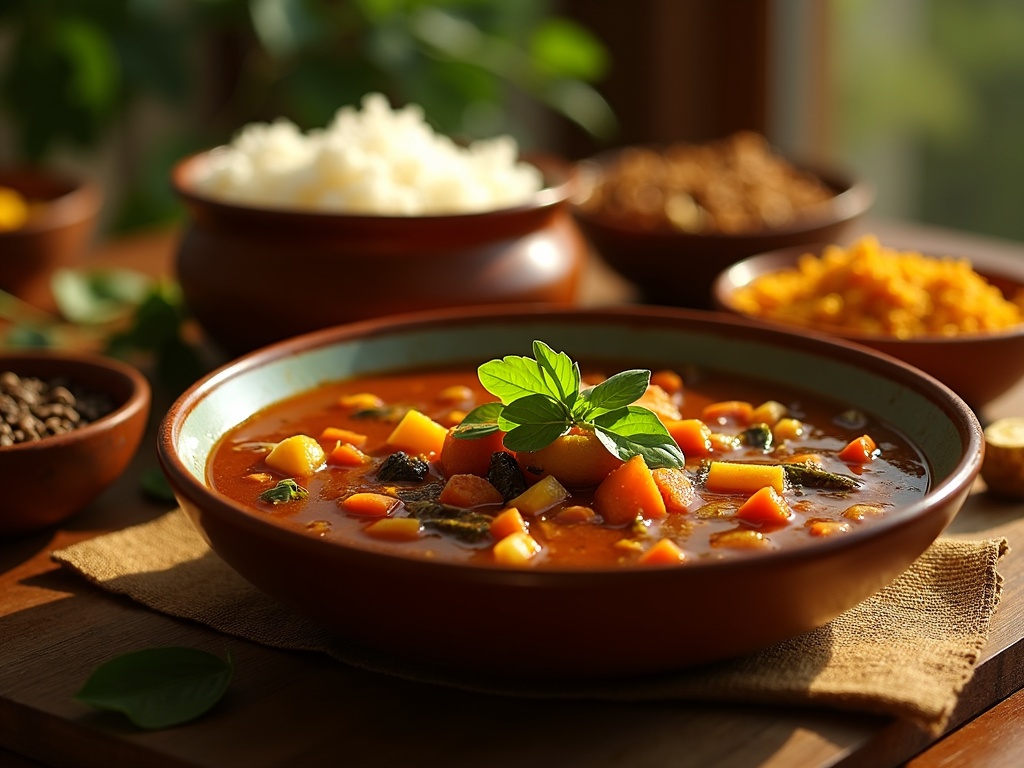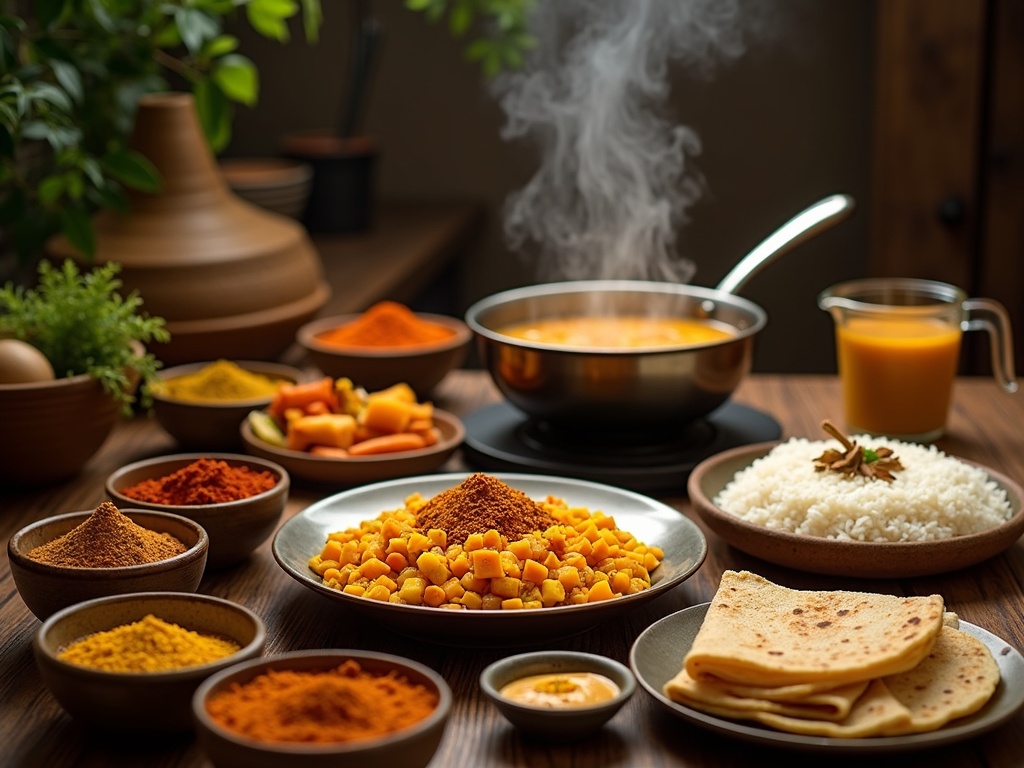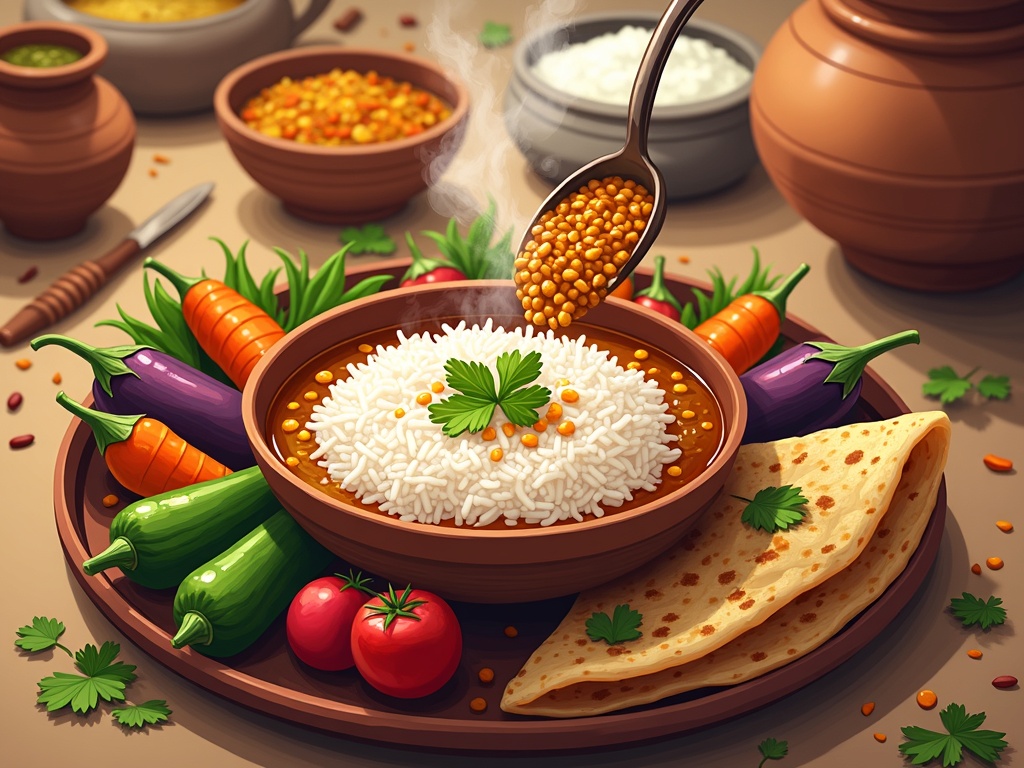Sambar recipe, a staple of South Indian cuisine, combines protein-rich lentils, fresh vegetables, and aromatic spices to create a tangy, flavorful stew that perfectly complements rice or dosa. This nutritional powerhouse serves as both a cultural heritage dish and an adaptable recipe that varies across regions, offering a balanced meal component that has transcended its origins to become beloved throughout India and beyond.
Find In This Article
Key Takeaways
- Authentic sambar requires core ingredients including toor dal (split pigeon peas), mixed vegetables, tamarind for tanginess, and a specific blend of spices.
- The dish provides impressive nutrition with 9-12 grams of protein and 6-8 grams of dietary fiber per cup, making it ideal for vegetarian diets.
- Regional variations exist across South India, with Tamil versions featuring more tamarind tang, Karnataka incorporating coconut, and Andhra preparations typically being spicier.
- The cooking process involves pressure-cooking lentils, preparing vegetables separately, and finishing with a flavorful tempering of mustard seeds, curry leaves and spices.
- Sambar can be stored in the refrigerator for 3-4 days or frozen for up to a month, with flavors often intensifying after a day of sitting.
The Heart of South Indian Cuisine: Understanding Sambar
Sambar stands as one of the most iconic dishes in South Indian cuisine – a flavorful lentil-based stew that combines vegetables, tamarind, and aromatic spices. I’ve found this hearty dish enjoys immense popularity throughout India, though it remains especially beloved in Tamil Nadu and Karnataka where it originated. Many South Indian meals feel incomplete without this nourishing accompaniment served alongside rice or crispy dosa with coconut chutney on the side.
Nutritional Powerhouse
The nutritional profile of sambar makes it much more than just a tasty dish. I consider it a complete meal component because it combines:
- Protein-rich lentils (typically toor dal) that provide essential amino acids
- Fresh vegetables contributing various vitamins and minerals
- Dietary fiber that aids digestion and provides satiety
- Complex carbohydrates delivering sustained energy
The combination of lentils with vegetables creates a balanced dish that satisfies hunger while providing exceptional nutrition. When paired with rice or other grains, sambar forms a complete protein, making it particularly valuable in vegetarian diets lacking animal protein sources.
Cultural Significance and Regional Variations
Sambar holds deep cultural significance across South India. I’ve observed how this dish serves as more than daily sustenance – it represents heritage and tradition passed through generations. In most South Indian homes, the recipe for sambar is treasured family knowledge, with subtle variations making each household’s version unique.
During festivals and celebrations, sambar takes center stage in traditional thali meals, where its rich flavors complement other dishes. The way sambar is prepared often indicates regional identity. Tamil sambar typically features a pronounced tamarind tang, while Karnataka variations might incorporate more coconut. Andhra versions tend to be spicier, and Kerala sambar resembles other dahl preparations with additional ingredients like coconut milk.
These regional adaptations reflect local ingredient availability and cultural preferences. Coastal regions might include seafood, while inland areas rely more heavily on seasonal vegetables. What fascinates me is how each region proudly maintains its distinctive sambar style while acknowledging the dish’s shared heritage.
The vegetables used in sambar also vary by region and season. While drumsticks, eggplant, and pumpkin are common additions, I’ve tasted versions featuring okra, carrots, tomatoes, and various tubers. This adaptability makes sambar both economical and sustainable, as cooks can use whatever vegetables are locally abundant.
The spice blend (sambar powder) varies significantly between regions too. Some areas emphasize coriander and red chilies, while others might feature more fenugreek or mustard seeds. These unique spice combinations resemble the regional variations found in chutney recipes throughout India.
The cooking method itself carries cultural significance. Traditional preparation involves slow simmering in earthen pots, allowing flavors to develop fully. Modern adaptations might use pressure cookers for convenience, but many cooks maintain that the authentic taste comes from patient, unhurried cooking.
I’ve noticed that serving sambar follows regional customs too. In Tamil Nadu, it’s commonly ladled over rice with a dollop of ghee, while in Karnataka, it might accompany special rice preparations similar to biryani. In restaurants serving South Indian cuisine, sambar invariably accompanies dosas, idlis, and vadas, creating that perfect balance of flavors and textures that makes these meals so satisfying.
The versatility of sambar speaks to its genius – it can serve as a main course, side dish, or accompaniment depending on how it’s prepared and presented. This adaptability has helped sambar transcend regional boundaries to become a beloved dish throughout India and beyond.
Power-Packed Nutrition You Need
Sambar isn’t just a flavor explosion – it’s also a nutritional powerhouse. This South Indian staple delivers impressive health benefits while satisfying your taste buds. Each cup serving contains approximately 150-200 calories, making it a perfect addition to a balanced meal without weighing you down.
The protein content in sambar is particularly notable. A single cup provides 9-12 grams of protein, which comes primarily from the lentils (toor dal). This makes sambar an excellent choice for anyone following a vegetable-based diet who needs to maintain adequate protein intake.
Fiber is another standout nutritional component. With 6-8 grams of dietary fiber per cup, sambar helps support digestive health and creates a feeling of fullness. This fiber, combined with approximately 25-30 grams of carbohydrates per serving, provides sustained energy throughout the day.
Vitamin and Mineral Content
The diverse ingredients in sambar contribute to its impressive vitamin and mineral profile:
- Vitamin C from tamarind pulp helps boost immunity and aids in iron absorption
- Folate from lentils supports cell function and is crucial for pregnant women
- Potassium from vegetables like drumsticks, carrots, and eggplant promotes heart health
- Iron from lentils helps prevent anemia and supports oxygen transport in the blood
- Antioxidants from spices like turmeric and curry leaves fight inflammation
For vegetarians and vegans, sambar serves as an ideal dal-based protein source. The combination of lentils with rice creates a complete protein profile, providing all essential amino acids the body needs.
The tempering process that uses ghee or oil helps in the absorption of fat-soluble vitamins. Meanwhile, the addition of coconut in the form of chutney or garnish adds healthy fats to the meal.
I’ve found that incorporating sambar into my weekly meal rotation has helped me maintain a balanced diet. The versatility of this dish allows for customization based on seasonal vegetables, making it easy to vary the nutritional profile. For instance, adding spinach boosts iron content, while extra tomatoes increase vitamin C levels.
When paired with vegetable biryani or steamed rice, sambar creates a filling meal that keeps me satisfied for hours. The slow-digesting complex carbohydrates prevent blood sugar spikes, making it suitable for those monitoring their glucose levels.
The combination of homemade chutney alongside sambar adds complementary nutrients, creating a more complete nutritional profile. This traditional pairing isn’t just about flavor – it’s a time-tested way to ensure balanced nutrition.
For those looking to enhance the protein content even further, adding a creamy dal side dish creates a protein-packed meal that can substitute for meat-based options. The plant-based proteins in these lentil combinations provide all the building blocks your body needs without animal products.
The spices used in sambar don’t just add flavor – they contain compounds with potential health benefits. Turmeric contains curcumin, known for its anti-inflammatory properties, while mustard seeds provide selenium, an important mineral for thyroid function.

Essential Ingredients for Perfect Sambar
Creating authentic sambar requires a careful balance of ingredients that work together to deliver its distinctive tangy and spicy flavor profile. I’ve found that quality ingredients make all the difference in this South Indian staple.
Core Components
Toor dal forms the foundation of any good sambar recipe. One cup of these split pigeon peas creates the perfect base consistency after cooking. I always soak them for 30 minutes before cooking to reduce cooking time.
Mixed vegetables add texture and nutrition to the dish. I typically use 2 cups of vegetables like carrots, beans, drumsticks, and pumpkin. You can customize these based on seasonal availability or personal preference. These vegetables complement the vegetable curry flavors while maintaining their distinct identity.
Tamarind provides the characteristic sourness that defines sambar. Two tablespoons of tamarind soaked in warm water and extracted gives the perfect tanginess. This sour note balances beautifully with the coconut chutney often served alongside.
The spice elements are crucial for authentic flavor:
- 2-3 tablespoons of sambar powder (varying based on heat preference)
- 1/2 teaspoon turmeric powder for color and health benefits
- 1 teaspoon mustard seeds for the tempering
- Fresh curry leaves for aromatic depth
The tempering process requires 1-2 tablespoons of oil – either vegetable or coconut oil works well. Coconut oil adds a regional authenticity if you’re aiming for a Kerala-style variation.
Salt brings all these flavors together, and I always add it to taste rather than following a strict measurement.
For garnish, fresh coriander leaves add a pop of color and freshness that complements the chutney recipes typically served alongside sambar.
When preparing sambar, I often make a larger batch of dahl as they share similar cooking techniques. The key difference lies in the spice mixture and tamarind component.
For special occasions, I serve sambar with veg biryani for a complete meal that showcases the diversity of Indian cuisine. The creamy consistency of sambar also pairs wonderfully with dal makhani for a pulse-rich feast.
Crafting Your Sambar
I start the sambar-making process by pressure cooking toor dal, which forms the protein-rich base of this South Indian classic. For every cup of toor dal, I add a quarter teaspoon of turmeric powder and 3 cups of water before pressure cooking until soft and mushy. This usually takes about 3-4 whistles on medium heat.
While the dal cooks, I prepare the vegetables. The beauty of sambar lies in its versatility – you can use whatever vegetables you have on hand. I typically chop carrots, drumsticks, eggplant, and potatoes into uniform pieces and boil them separately until just tender. This ensures each vegetable retains its distinct texture in the final vegetable curry blend.
Once the dal is cooked, I mash it thoroughly with a ladle to achieve that perfect creamy consistency. Then I combine the mashed dal with the cooked vegetables in a large pot.
Creating Depth of Flavor
The distinctive tanginess of sambar comes from tamarind. I soak a small lemon-sized ball of tamarind in warm water, extract the juice, and add it to the dal-vegetable mixture. Next comes the sambar powder – the aromatic spice blend that gives this dish its signature flavor. If you don’t have store-bought sambar powder, you can make your own homemade spice blend by roasting and grinding coriander seeds, red chilies, and other spices.
I let the mixture simmer for 10-15 minutes on medium heat, allowing the flavors to meld beautifully. During this time, I prepare the tempering that will elevate the sambar to new heights. In a small pan, I heat oil or ghee and add:
- Mustard seeds (wait for them to splutter)
- Curry leaves (for that distinct aroma)
- Dried red chilies (for heat)
- Asafoetida (a pinch for digestive benefits)
This tempering gets poured over the simmering sambar, creating that distinctive sizzle and aroma that fills the kitchen. I cover and let everything cook for another 5 minutes, allowing the flavors to marry perfectly. Before serving, I garnish with fresh coriander leaves for a burst of color and freshness.
Sambar pairs wonderfully with steamed rice, lentil preparations, or traditional South Indian coconut chutney and crispy dosas. For a complete meal, serve it alongside vegetable biryani for a feast that celebrates the rich tapestry of Indian cuisine.

Expert Tips and Serving Suggestions
Roasting the sambar powder before adding it to your dish creates a deeper flavor profile. I heat a dry pan over medium heat and toast the spices for about 30 seconds until they become fragrant. This simple step transforms your sambar from good to exceptional, releasing essential oils in the spices.
The consistency of sambar can be tailored to your preference. If it’s too thick, I add warm water gradually while stirring to avoid lumps. For a thicker consistency perfect for dipping, I let it simmer uncovered for a few extra minutes.
Storage Solutions
Sambar keeps remarkably well when stored properly. I transfer cooled sambar to an airtight container and refrigerate it for 3-4 days. For longer storage, I portion it into freezer-safe containers and freeze for up to a month. The flavors often intensify after a day, making leftovers even more delicious.
When reheating, I add a splash of water as the lentils tend to absorb liquid while sitting. A gentle simmer restores the original consistency without compromising flavor.
Pairing and Serving Ideas
Sambar has incredible versatility when it comes to pairings. I love serving it with steaming rice, where the grains soak up the flavorful broth. It’s also perfect alongside coconut chutney and South Indian breakfast items like idli or dosa.
For a complete meal experience, try these classic combinations:
- Plain rice with a ladle of hot sambar and a side of homemade chutney
- Crispy dosas filled with potato masala and sambar for dipping
- Soft, fluffy idlis with sambar poured over them
- As a side dish to vegetable biryani for a fusion meal
The beauty of sambar lies in its adaptability. I customize mine with seasonal vegetables, switching between drumsticks, pumpkin, or carrots depending on availability. This approach not only keeps the dish interesting but also ensures you’re getting the freshest ingredients.
For a richer flavor profile, I sometimes add a vegetable curry element by increasing the spice level and reducing the water content. This creates a thicker consistency perfect for special occasions.
Sambar pairs wonderfully with other lentil dishes like dahl or dal makhani for a protein-rich meal that showcases the diversity of Indian lentil preparations.

Sources:
Indian Cuisine: A Historical Overview – Dr. Sudha Ramalingam
The Nutritional Benefits of Lentils – Journal of Nutritional Science
Understanding Indian Spices – The Spice Council India
The Art of South Indian Cooking – Aruna Chintamani

